Myopathy: Exploring Muscle Disorders, Diagnosis, and Treatment
VerifiedAdded on 2022/09/25
|8
|1766
|20
Report
AI Summary
This report provides a comprehensive overview of myopathy, a rare muscle disorder affecting muscle function. It details various types of myopathy, including Myoglobinurias and Mitochondrial myopathy, outlining their distinct symptoms and causes. The report explores the impact of myopathy on the body, focusing on the arms, legs, and other affected areas, along with clinical pictures. It also discusses the causes of myopathy, such as muscle inflammation, electrolyte imbalances, and genetic factors. Assessment methods, including electrophysiologic testing and molecular genetics, are examined. The report further delves into traditional physical therapy treatments, like aerobic activities and anti-inflammatory drugs, and highlights emerging trends such as gene therapy and stem-cell transplantation. Finally, it compares healthy individuals to those with myopathy, emphasizing the structural and physiological differences in their muscles. The report concludes by emphasizing the importance of medical attention for myopathy and its potential progression into more severe conditions like muscular dystrophy. The report includes several references to support the information provided.
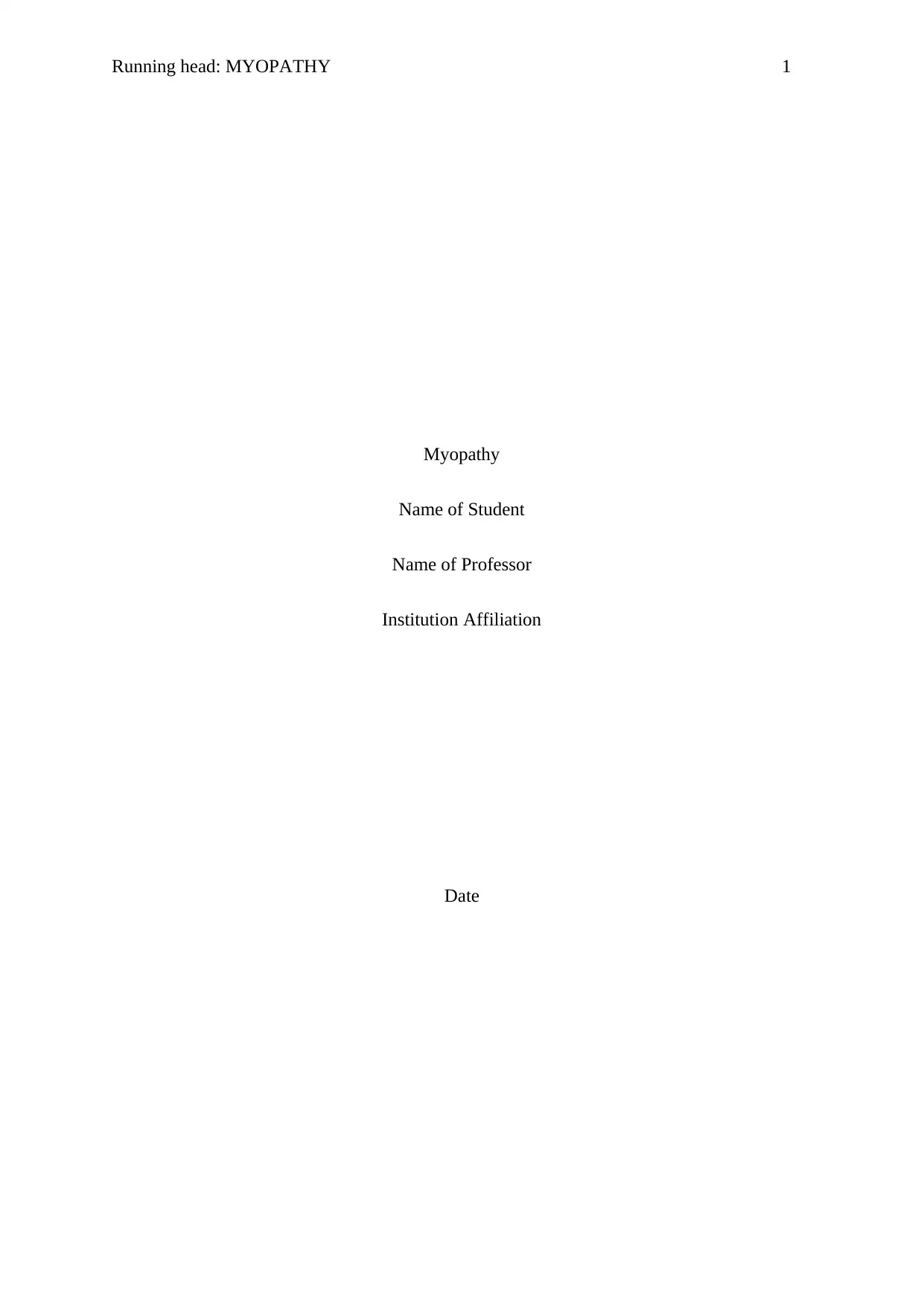
Running head: MYOPATHY 1
Myopathy
Name of Student
Name of Professor
Institution Affiliation
Date
Myopathy
Name of Student
Name of Professor
Institution Affiliation
Date
Paraphrase This Document
Need a fresh take? Get an instant paraphrase of this document with our AI Paraphraser
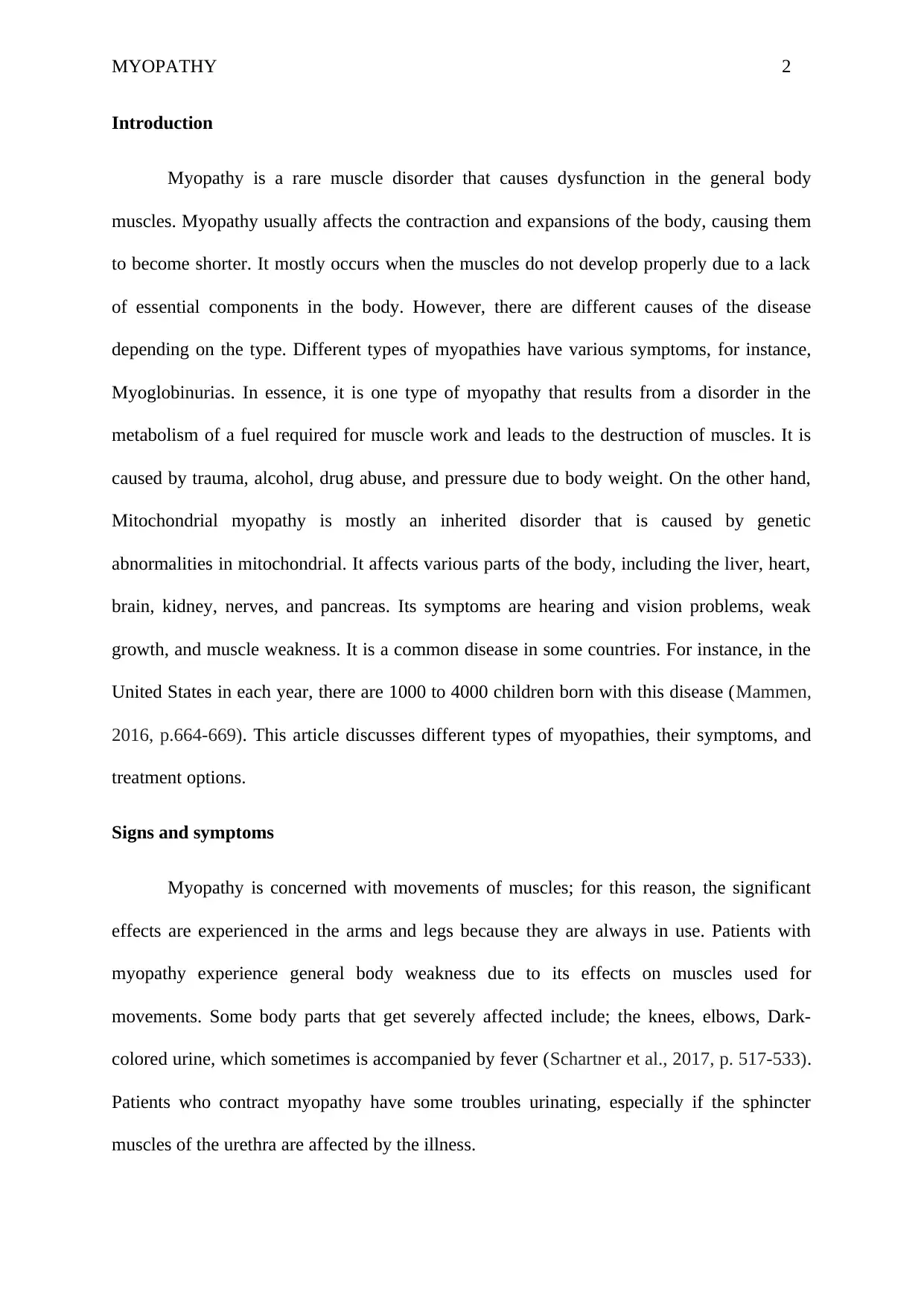
MYOPATHY 2
Introduction
Myopathy is a rare muscle disorder that causes dysfunction in the general body
muscles. Myopathy usually affects the contraction and expansions of the body, causing them
to become shorter. It mostly occurs when the muscles do not develop properly due to a lack
of essential components in the body. However, there are different causes of the disease
depending on the type. Different types of myopathies have various symptoms, for instance,
Myoglobinurias. In essence, it is one type of myopathy that results from a disorder in the
metabolism of a fuel required for muscle work and leads to the destruction of muscles. It is
caused by trauma, alcohol, drug abuse, and pressure due to body weight. On the other hand,
Mitochondrial myopathy is mostly an inherited disorder that is caused by genetic
abnormalities in mitochondrial. It affects various parts of the body, including the liver, heart,
brain, kidney, nerves, and pancreas. Its symptoms are hearing and vision problems, weak
growth, and muscle weakness. It is a common disease in some countries. For instance, in the
United States in each year, there are 1000 to 4000 children born with this disease (Mammen,
2016, p.664-669). This article discusses different types of myopathies, their symptoms, and
treatment options.
Signs and symptoms
Myopathy is concerned with movements of muscles; for this reason, the significant
effects are experienced in the arms and legs because they are always in use. Patients with
myopathy experience general body weakness due to its effects on muscles used for
movements. Some body parts that get severely affected include; the knees, elbows, Dark-
colored urine, which sometimes is accompanied by fever (Schartner et al., 2017, p. 517-533).
Patients who contract myopathy have some troubles urinating, especially if the sphincter
muscles of the urethra are affected by the illness.
Introduction
Myopathy is a rare muscle disorder that causes dysfunction in the general body
muscles. Myopathy usually affects the contraction and expansions of the body, causing them
to become shorter. It mostly occurs when the muscles do not develop properly due to a lack
of essential components in the body. However, there are different causes of the disease
depending on the type. Different types of myopathies have various symptoms, for instance,
Myoglobinurias. In essence, it is one type of myopathy that results from a disorder in the
metabolism of a fuel required for muscle work and leads to the destruction of muscles. It is
caused by trauma, alcohol, drug abuse, and pressure due to body weight. On the other hand,
Mitochondrial myopathy is mostly an inherited disorder that is caused by genetic
abnormalities in mitochondrial. It affects various parts of the body, including the liver, heart,
brain, kidney, nerves, and pancreas. Its symptoms are hearing and vision problems, weak
growth, and muscle weakness. It is a common disease in some countries. For instance, in the
United States in each year, there are 1000 to 4000 children born with this disease (Mammen,
2016, p.664-669). This article discusses different types of myopathies, their symptoms, and
treatment options.
Signs and symptoms
Myopathy is concerned with movements of muscles; for this reason, the significant
effects are experienced in the arms and legs because they are always in use. Patients with
myopathy experience general body weakness due to its effects on muscles used for
movements. Some body parts that get severely affected include; the knees, elbows, Dark-
colored urine, which sometimes is accompanied by fever (Schartner et al., 2017, p. 517-533).
Patients who contract myopathy have some troubles urinating, especially if the sphincter
muscles of the urethra are affected by the illness.
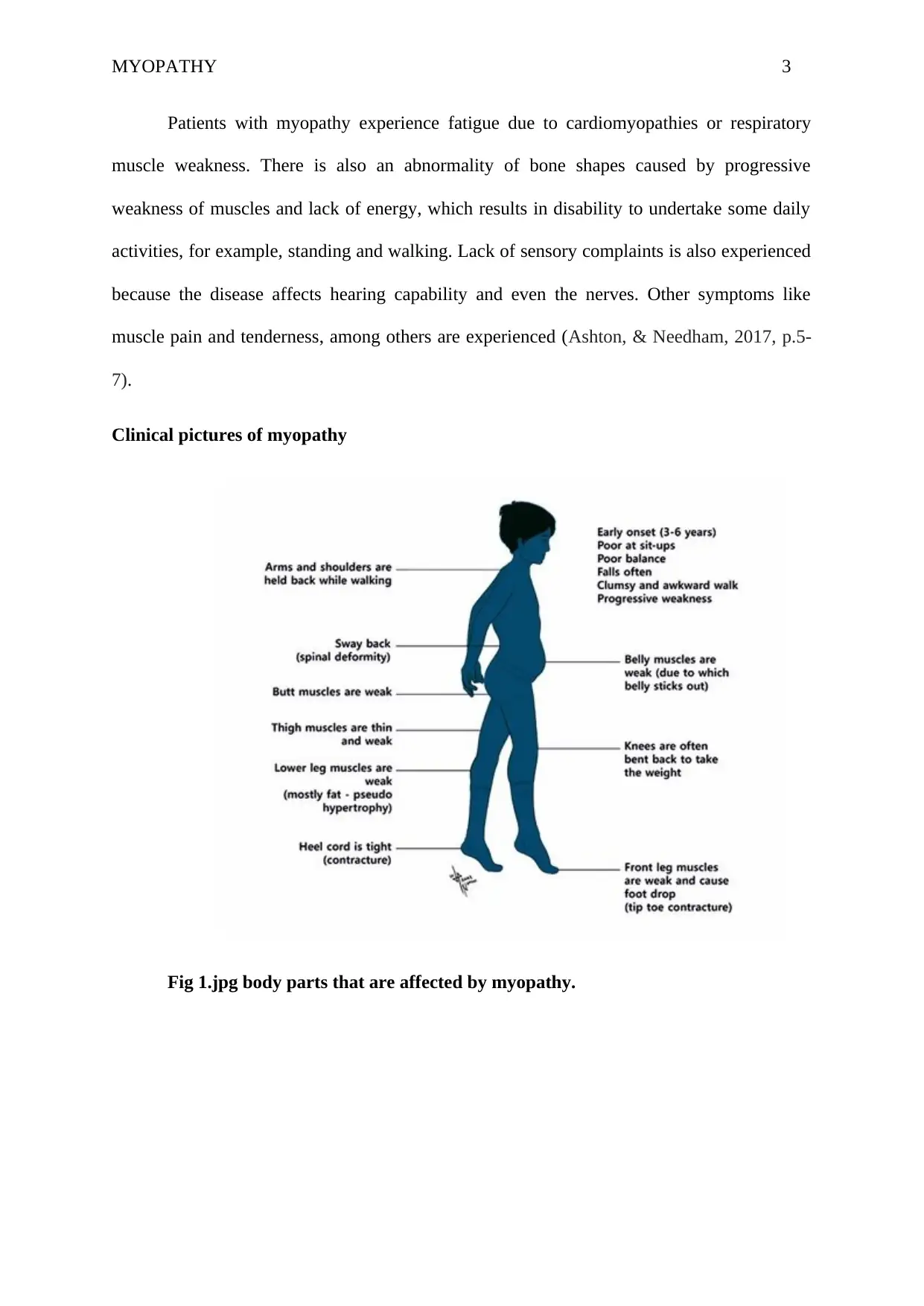
MYOPATHY 3
Patients with myopathy experience fatigue due to cardiomyopathies or respiratory
muscle weakness. There is also an abnormality of bone shapes caused by progressive
weakness of muscles and lack of energy, which results in disability to undertake some daily
activities, for example, standing and walking. Lack of sensory complaints is also experienced
because the disease affects hearing capability and even the nerves. Other symptoms like
muscle pain and tenderness, among others are experienced (Ashton, & Needham, 2017, p.5-
7).
Clinical pictures of myopathy
Fig 1.jpg body parts that are affected by myopathy.
Patients with myopathy experience fatigue due to cardiomyopathies or respiratory
muscle weakness. There is also an abnormality of bone shapes caused by progressive
weakness of muscles and lack of energy, which results in disability to undertake some daily
activities, for example, standing and walking. Lack of sensory complaints is also experienced
because the disease affects hearing capability and even the nerves. Other symptoms like
muscle pain and tenderness, among others are experienced (Ashton, & Needham, 2017, p.5-
7).
Clinical pictures of myopathy
Fig 1.jpg body parts that are affected by myopathy.
⊘ This is a preview!⊘
Do you want full access?
Subscribe today to unlock all pages.

Trusted by 1+ million students worldwide
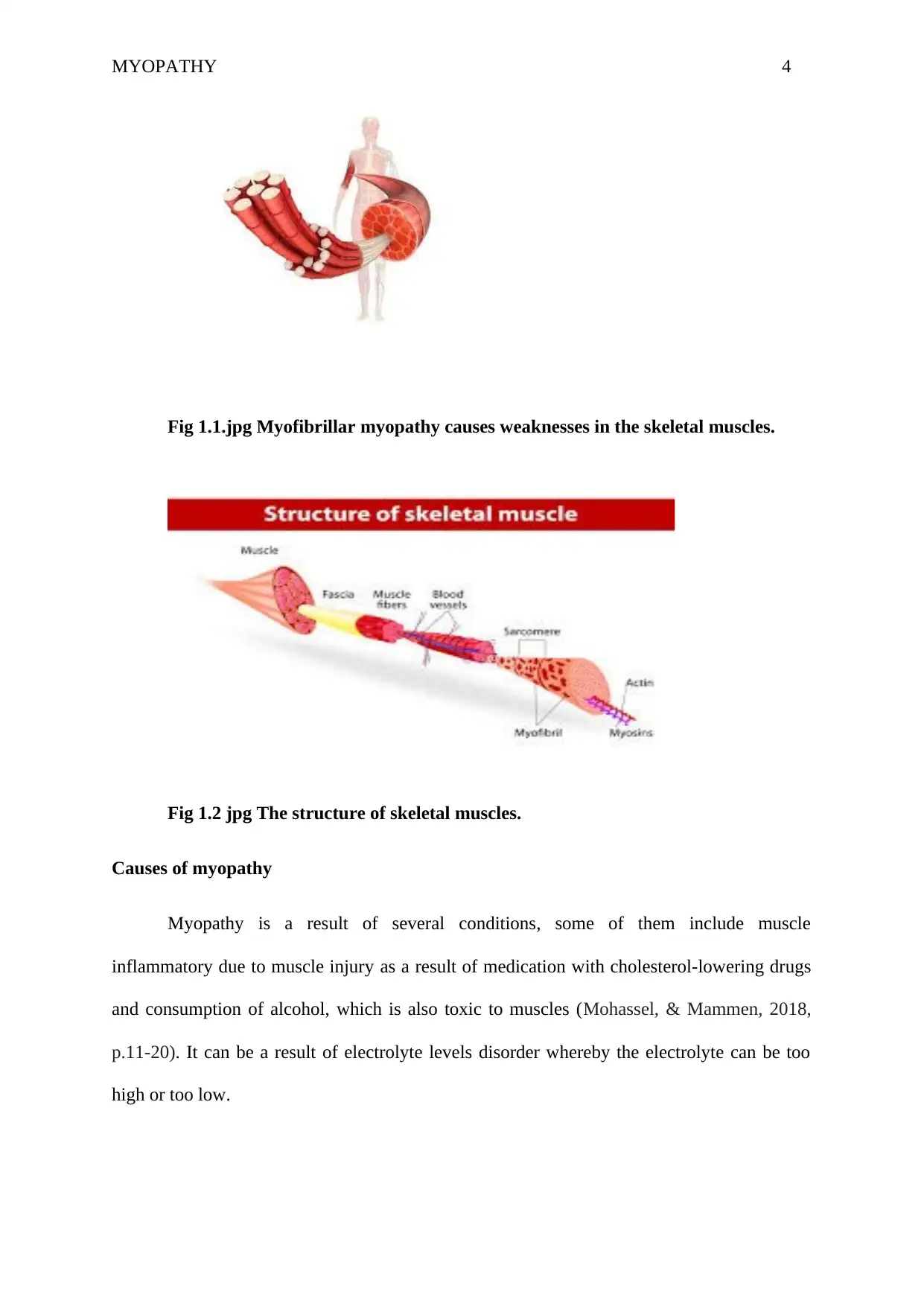
MYOPATHY 4
Fig 1.1.jpg Myofibrillar myopathy causes weaknesses in the skeletal muscles.
Fig 1.2 jpg The structure of skeletal muscles.
Causes of myopathy
Myopathy is a result of several conditions, some of them include muscle
inflammatory due to muscle injury as a result of medication with cholesterol-lowering drugs
and consumption of alcohol, which is also toxic to muscles (Mohassel, & Mammen, 2018,
p.11-20). It can be a result of electrolyte levels disorder whereby the electrolyte can be too
high or too low.
Fig 1.1.jpg Myofibrillar myopathy causes weaknesses in the skeletal muscles.
Fig 1.2 jpg The structure of skeletal muscles.
Causes of myopathy
Myopathy is a result of several conditions, some of them include muscle
inflammatory due to muscle injury as a result of medication with cholesterol-lowering drugs
and consumption of alcohol, which is also toxic to muscles (Mohassel, & Mammen, 2018,
p.11-20). It can be a result of electrolyte levels disorder whereby the electrolyte can be too
high or too low.
Paraphrase This Document
Need a fresh take? Get an instant paraphrase of this document with our AI Paraphraser
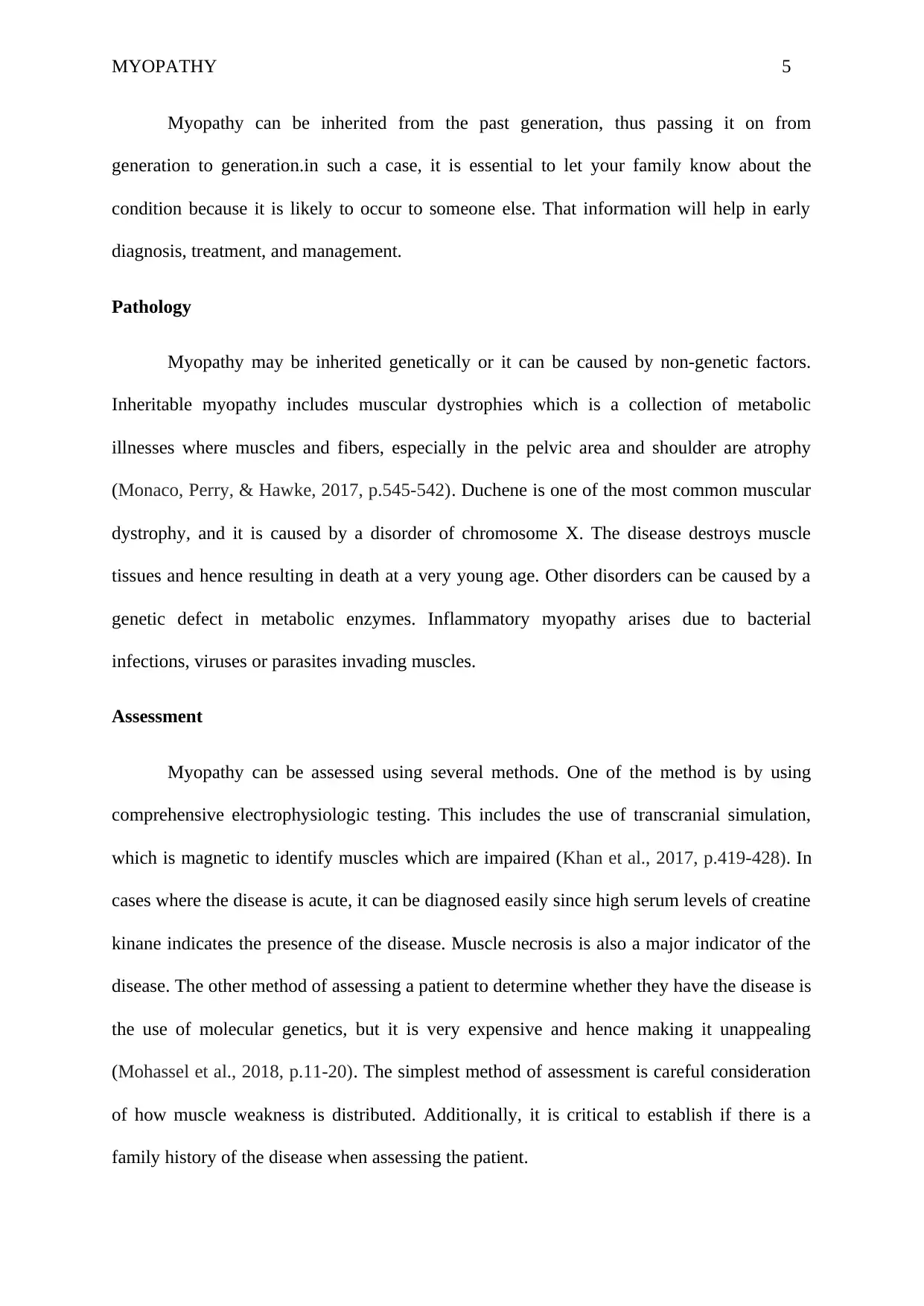
MYOPATHY 5
Myopathy can be inherited from the past generation, thus passing it on from
generation to generation.in such a case, it is essential to let your family know about the
condition because it is likely to occur to someone else. That information will help in early
diagnosis, treatment, and management.
Pathology
Myopathy may be inherited genetically or it can be caused by non-genetic factors.
Inheritable myopathy includes muscular dystrophies which is a collection of metabolic
illnesses where muscles and fibers, especially in the pelvic area and shoulder are atrophy
(Monaco, Perry, & Hawke, 2017, p.545-542). Duchene is one of the most common muscular
dystrophy, and it is caused by a disorder of chromosome X. The disease destroys muscle
tissues and hence resulting in death at a very young age. Other disorders can be caused by a
genetic defect in metabolic enzymes. Inflammatory myopathy arises due to bacterial
infections, viruses or parasites invading muscles.
Assessment
Myopathy can be assessed using several methods. One of the method is by using
comprehensive electrophysiologic testing. This includes the use of transcranial simulation,
which is magnetic to identify muscles which are impaired (Khan et al., 2017, p.419-428). In
cases where the disease is acute, it can be diagnosed easily since high serum levels of creatine
kinane indicates the presence of the disease. Muscle necrosis is also a major indicator of the
disease. The other method of assessing a patient to determine whether they have the disease is
the use of molecular genetics, but it is very expensive and hence making it unappealing
(Mohassel et al., 2018, p.11-20). The simplest method of assessment is careful consideration
of how muscle weakness is distributed. Additionally, it is critical to establish if there is a
family history of the disease when assessing the patient.
Myopathy can be inherited from the past generation, thus passing it on from
generation to generation.in such a case, it is essential to let your family know about the
condition because it is likely to occur to someone else. That information will help in early
diagnosis, treatment, and management.
Pathology
Myopathy may be inherited genetically or it can be caused by non-genetic factors.
Inheritable myopathy includes muscular dystrophies which is a collection of metabolic
illnesses where muscles and fibers, especially in the pelvic area and shoulder are atrophy
(Monaco, Perry, & Hawke, 2017, p.545-542). Duchene is one of the most common muscular
dystrophy, and it is caused by a disorder of chromosome X. The disease destroys muscle
tissues and hence resulting in death at a very young age. Other disorders can be caused by a
genetic defect in metabolic enzymes. Inflammatory myopathy arises due to bacterial
infections, viruses or parasites invading muscles.
Assessment
Myopathy can be assessed using several methods. One of the method is by using
comprehensive electrophysiologic testing. This includes the use of transcranial simulation,
which is magnetic to identify muscles which are impaired (Khan et al., 2017, p.419-428). In
cases where the disease is acute, it can be diagnosed easily since high serum levels of creatine
kinane indicates the presence of the disease. Muscle necrosis is also a major indicator of the
disease. The other method of assessing a patient to determine whether they have the disease is
the use of molecular genetics, but it is very expensive and hence making it unappealing
(Mohassel et al., 2018, p.11-20). The simplest method of assessment is careful consideration
of how muscle weakness is distributed. Additionally, it is critical to establish if there is a
family history of the disease when assessing the patient.
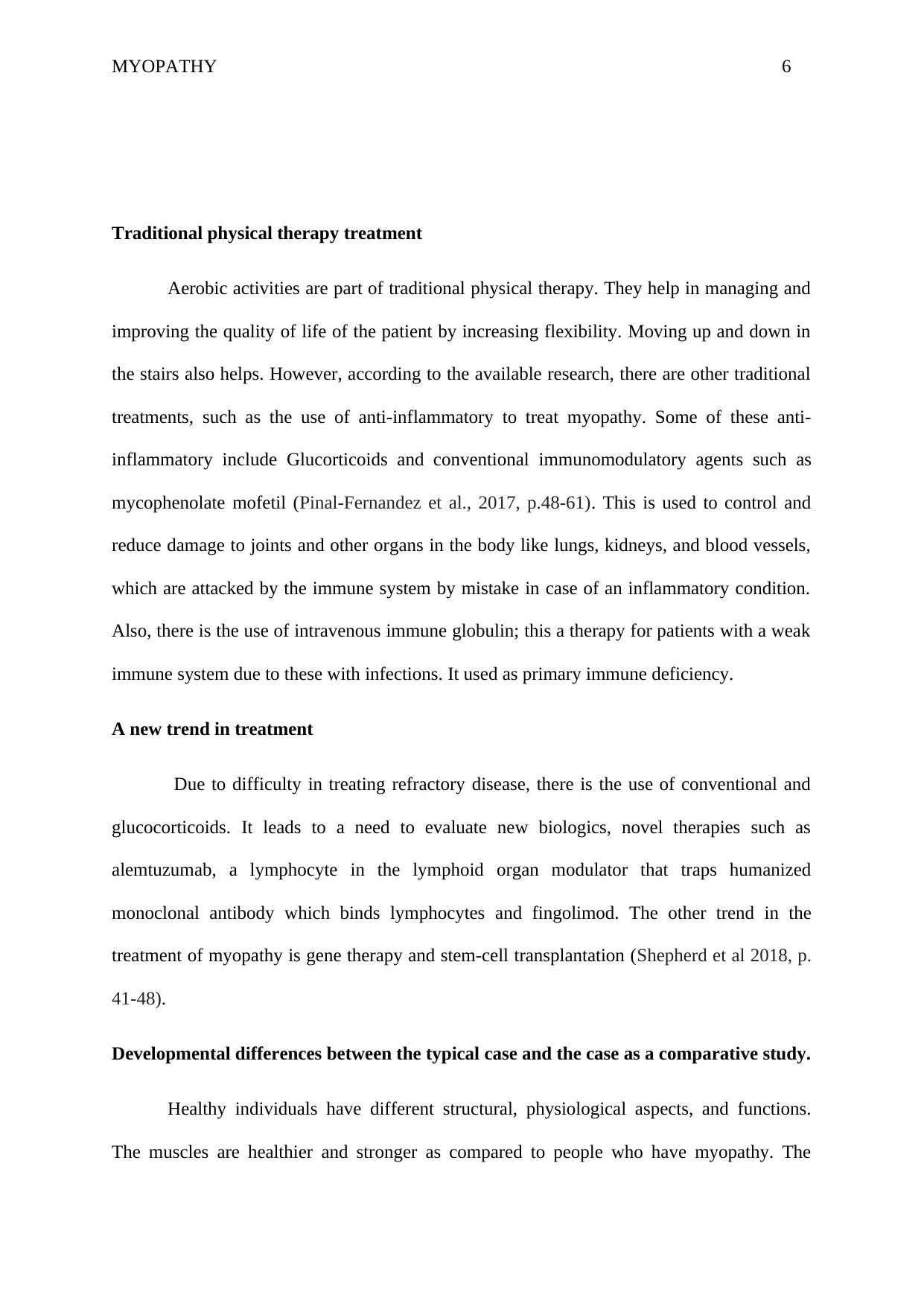
MYOPATHY 6
Traditional physical therapy treatment
Aerobic activities are part of traditional physical therapy. They help in managing and
improving the quality of life of the patient by increasing flexibility. Moving up and down in
the stairs also helps. However, according to the available research, there are other traditional
treatments, such as the use of anti-inflammatory to treat myopathy. Some of these anti-
inflammatory include Glucorticoids and conventional immunomodulatory agents such as
mycophenolate mofetil (Pinal-Fernandez et al., 2017, p.48-61). This is used to control and
reduce damage to joints and other organs in the body like lungs, kidneys, and blood vessels,
which are attacked by the immune system by mistake in case of an inflammatory condition.
Also, there is the use of intravenous immune globulin; this a therapy for patients with a weak
immune system due to these with infections. It used as primary immune deficiency.
A new trend in treatment
Due to difficulty in treating refractory disease, there is the use of conventional and
glucocorticoids. It leads to a need to evaluate new biologics, novel therapies such as
alemtuzumab, a lymphocyte in the lymphoid organ modulator that traps humanized
monoclonal antibody which binds lymphocytes and fingolimod. The other trend in the
treatment of myopathy is gene therapy and stem-cell transplantation (Shepherd et al 2018, p.
41-48).
Developmental differences between the typical case and the case as a comparative study.
Healthy individuals have different structural, physiological aspects, and functions.
The muscles are healthier and stronger as compared to people who have myopathy. The
Traditional physical therapy treatment
Aerobic activities are part of traditional physical therapy. They help in managing and
improving the quality of life of the patient by increasing flexibility. Moving up and down in
the stairs also helps. However, according to the available research, there are other traditional
treatments, such as the use of anti-inflammatory to treat myopathy. Some of these anti-
inflammatory include Glucorticoids and conventional immunomodulatory agents such as
mycophenolate mofetil (Pinal-Fernandez et al., 2017, p.48-61). This is used to control and
reduce damage to joints and other organs in the body like lungs, kidneys, and blood vessels,
which are attacked by the immune system by mistake in case of an inflammatory condition.
Also, there is the use of intravenous immune globulin; this a therapy for patients with a weak
immune system due to these with infections. It used as primary immune deficiency.
A new trend in treatment
Due to difficulty in treating refractory disease, there is the use of conventional and
glucocorticoids. It leads to a need to evaluate new biologics, novel therapies such as
alemtuzumab, a lymphocyte in the lymphoid organ modulator that traps humanized
monoclonal antibody which binds lymphocytes and fingolimod. The other trend in the
treatment of myopathy is gene therapy and stem-cell transplantation (Shepherd et al 2018, p.
41-48).
Developmental differences between the typical case and the case as a comparative study.
Healthy individuals have different structural, physiological aspects, and functions.
The muscles are healthier and stronger as compared to people who have myopathy. The
⊘ This is a preview!⊘
Do you want full access?
Subscribe today to unlock all pages.

Trusted by 1+ million students worldwide
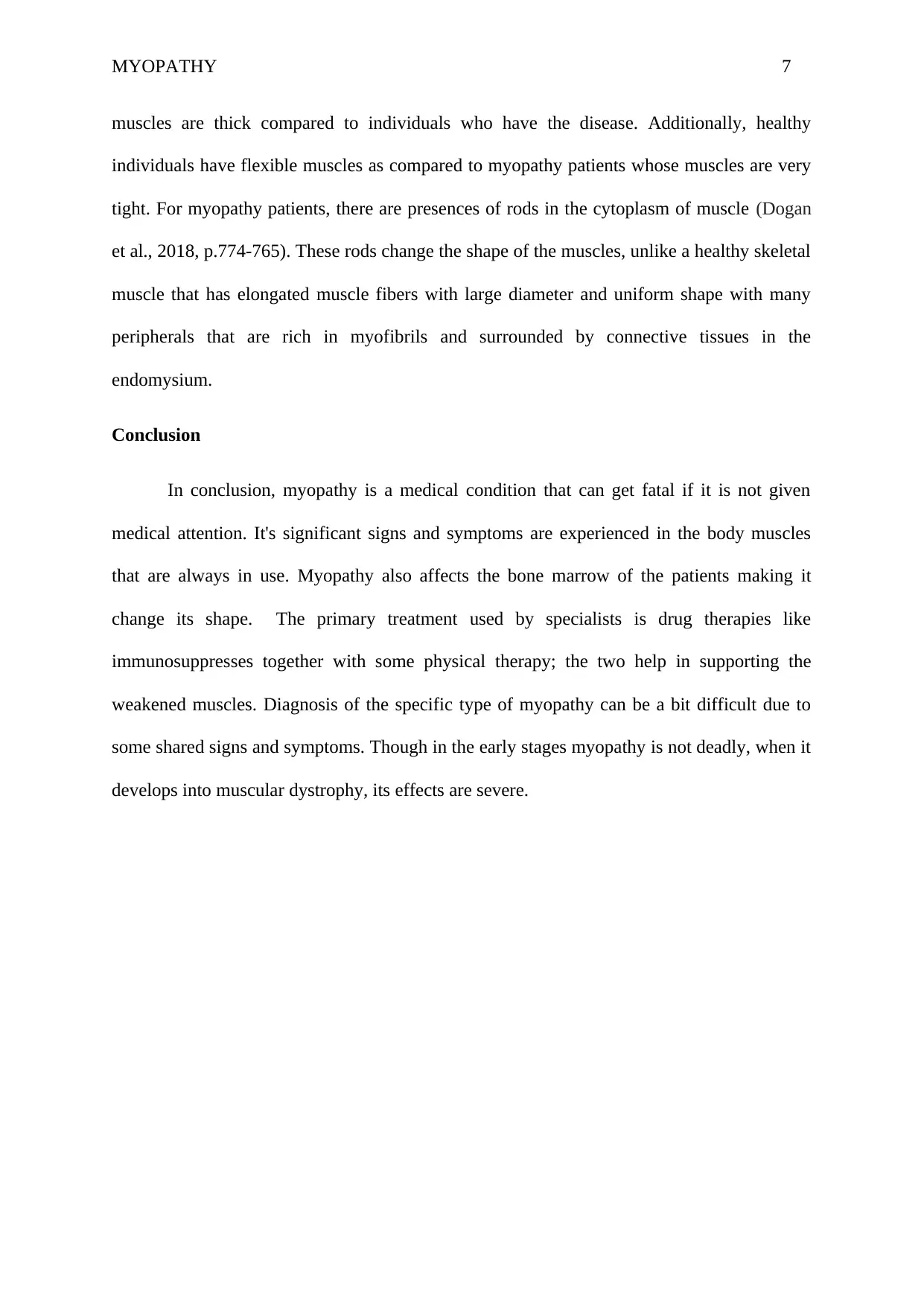
MYOPATHY 7
muscles are thick compared to individuals who have the disease. Additionally, healthy
individuals have flexible muscles as compared to myopathy patients whose muscles are very
tight. For myopathy patients, there are presences of rods in the cytoplasm of muscle (Dogan
et al., 2018, p.774-765). These rods change the shape of the muscles, unlike a healthy skeletal
muscle that has elongated muscle fibers with large diameter and uniform shape with many
peripherals that are rich in myofibrils and surrounded by connective tissues in the
endomysium.
Conclusion
In conclusion, myopathy is a medical condition that can get fatal if it is not given
medical attention. It's significant signs and symptoms are experienced in the body muscles
that are always in use. Myopathy also affects the bone marrow of the patients making it
change its shape. The primary treatment used by specialists is drug therapies like
immunosuppresses together with some physical therapy; the two help in supporting the
weakened muscles. Diagnosis of the specific type of myopathy can be a bit difficult due to
some shared signs and symptoms. Though in the early stages myopathy is not deadly, when it
develops into muscular dystrophy, its effects are severe.
muscles are thick compared to individuals who have the disease. Additionally, healthy
individuals have flexible muscles as compared to myopathy patients whose muscles are very
tight. For myopathy patients, there are presences of rods in the cytoplasm of muscle (Dogan
et al., 2018, p.774-765). These rods change the shape of the muscles, unlike a healthy skeletal
muscle that has elongated muscle fibers with large diameter and uniform shape with many
peripherals that are rich in myofibrils and surrounded by connective tissues in the
endomysium.
Conclusion
In conclusion, myopathy is a medical condition that can get fatal if it is not given
medical attention. It's significant signs and symptoms are experienced in the body muscles
that are always in use. Myopathy also affects the bone marrow of the patients making it
change its shape. The primary treatment used by specialists is drug therapies like
immunosuppresses together with some physical therapy; the two help in supporting the
weakened muscles. Diagnosis of the specific type of myopathy can be a bit difficult due to
some shared signs and symptoms. Though in the early stages myopathy is not deadly, when it
develops into muscular dystrophy, its effects are severe.
Paraphrase This Document
Need a fresh take? Get an instant paraphrase of this document with our AI Paraphraser
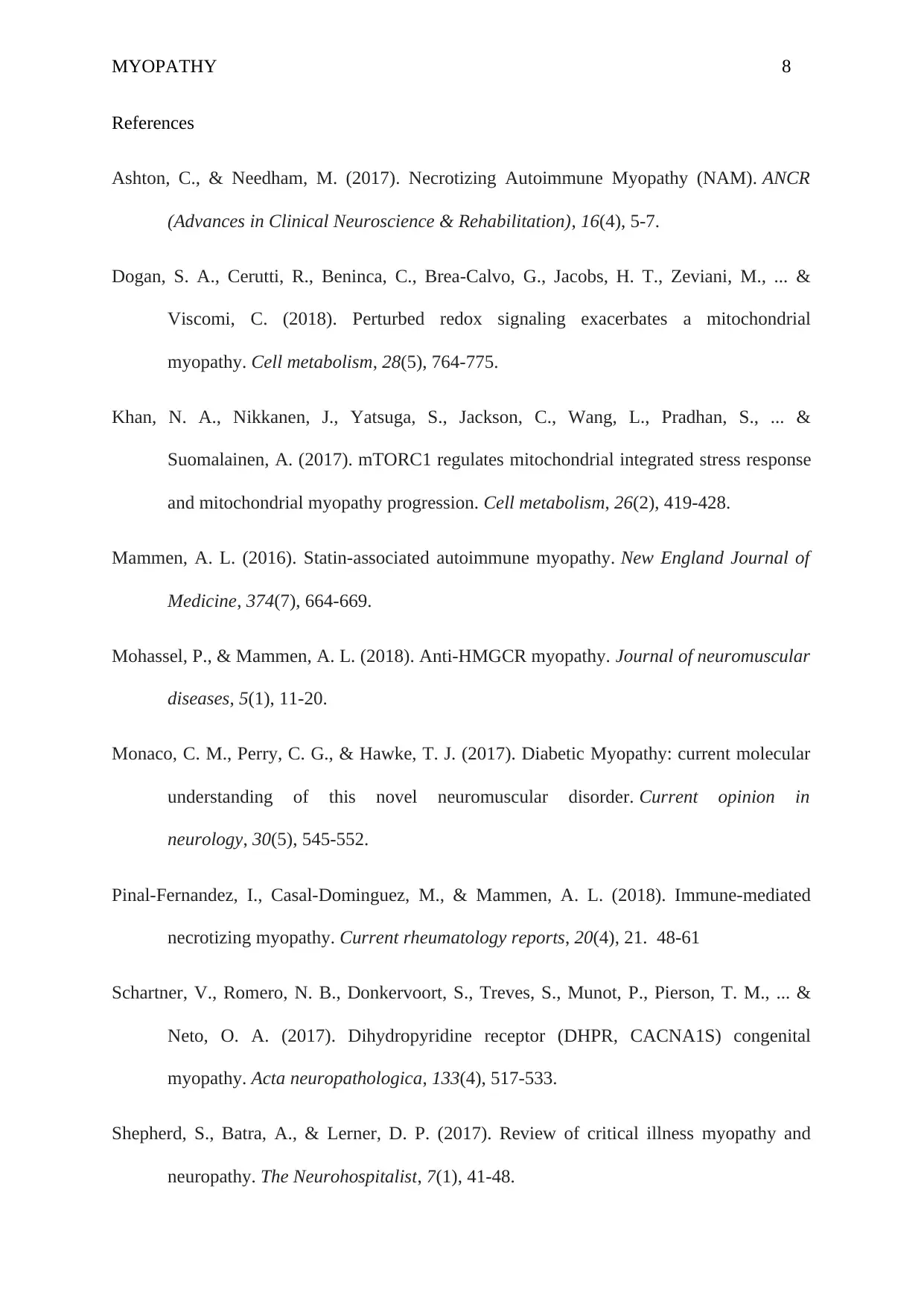
MYOPATHY 8
References
Ashton, C., & Needham, M. (2017). Necrotizing Autoimmune Myopathy (NAM). ANCR
(Advances in Clinical Neuroscience & Rehabilitation), 16(4), 5-7.
Dogan, S. A., Cerutti, R., Beninca, C., Brea-Calvo, G., Jacobs, H. T., Zeviani, M., ... &
Viscomi, C. (2018). Perturbed redox signaling exacerbates a mitochondrial
myopathy. Cell metabolism, 28(5), 764-775.
Khan, N. A., Nikkanen, J., Yatsuga, S., Jackson, C., Wang, L., Pradhan, S., ... &
Suomalainen, A. (2017). mTORC1 regulates mitochondrial integrated stress response
and mitochondrial myopathy progression. Cell metabolism, 26(2), 419-428.
Mammen, A. L. (2016). Statin-associated autoimmune myopathy. New England Journal of
Medicine, 374(7), 664-669.
Mohassel, P., & Mammen, A. L. (2018). Anti-HMGCR myopathy. Journal of neuromuscular
diseases, 5(1), 11-20.
Monaco, C. M., Perry, C. G., & Hawke, T. J. (2017). Diabetic Myopathy: current molecular
understanding of this novel neuromuscular disorder. Current opinion in
neurology, 30(5), 545-552.
Pinal-Fernandez, I., Casal-Dominguez, M., & Mammen, A. L. (2018). Immune-mediated
necrotizing myopathy. Current rheumatology reports, 20(4), 21. 48-61
Schartner, V., Romero, N. B., Donkervoort, S., Treves, S., Munot, P., Pierson, T. M., ... &
Neto, O. A. (2017). Dihydropyridine receptor (DHPR, CACNA1S) congenital
myopathy. Acta neuropathologica, 133(4), 517-533.
Shepherd, S., Batra, A., & Lerner, D. P. (2017). Review of critical illness myopathy and
neuropathy. The Neurohospitalist, 7(1), 41-48.
References
Ashton, C., & Needham, M. (2017). Necrotizing Autoimmune Myopathy (NAM). ANCR
(Advances in Clinical Neuroscience & Rehabilitation), 16(4), 5-7.
Dogan, S. A., Cerutti, R., Beninca, C., Brea-Calvo, G., Jacobs, H. T., Zeviani, M., ... &
Viscomi, C. (2018). Perturbed redox signaling exacerbates a mitochondrial
myopathy. Cell metabolism, 28(5), 764-775.
Khan, N. A., Nikkanen, J., Yatsuga, S., Jackson, C., Wang, L., Pradhan, S., ... &
Suomalainen, A. (2017). mTORC1 regulates mitochondrial integrated stress response
and mitochondrial myopathy progression. Cell metabolism, 26(2), 419-428.
Mammen, A. L. (2016). Statin-associated autoimmune myopathy. New England Journal of
Medicine, 374(7), 664-669.
Mohassel, P., & Mammen, A. L. (2018). Anti-HMGCR myopathy. Journal of neuromuscular
diseases, 5(1), 11-20.
Monaco, C. M., Perry, C. G., & Hawke, T. J. (2017). Diabetic Myopathy: current molecular
understanding of this novel neuromuscular disorder. Current opinion in
neurology, 30(5), 545-552.
Pinal-Fernandez, I., Casal-Dominguez, M., & Mammen, A. L. (2018). Immune-mediated
necrotizing myopathy. Current rheumatology reports, 20(4), 21. 48-61
Schartner, V., Romero, N. B., Donkervoort, S., Treves, S., Munot, P., Pierson, T. M., ... &
Neto, O. A. (2017). Dihydropyridine receptor (DHPR, CACNA1S) congenital
myopathy. Acta neuropathologica, 133(4), 517-533.
Shepherd, S., Batra, A., & Lerner, D. P. (2017). Review of critical illness myopathy and
neuropathy. The Neurohospitalist, 7(1), 41-48.
1 out of 8
Related Documents
Your All-in-One AI-Powered Toolkit for Academic Success.
+13062052269
info@desklib.com
Available 24*7 on WhatsApp / Email
![[object Object]](/_next/static/media/star-bottom.7253800d.svg)
Unlock your academic potential
Copyright © 2020–2025 A2Z Services. All Rights Reserved. Developed and managed by ZUCOL.




